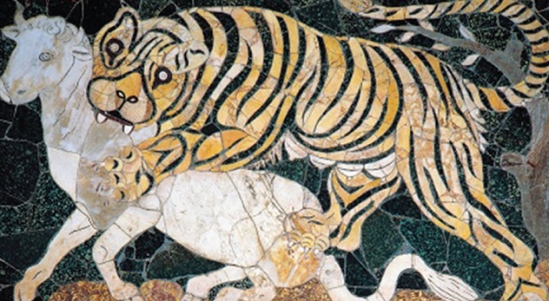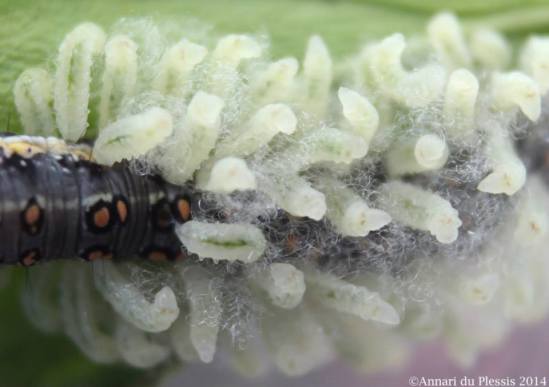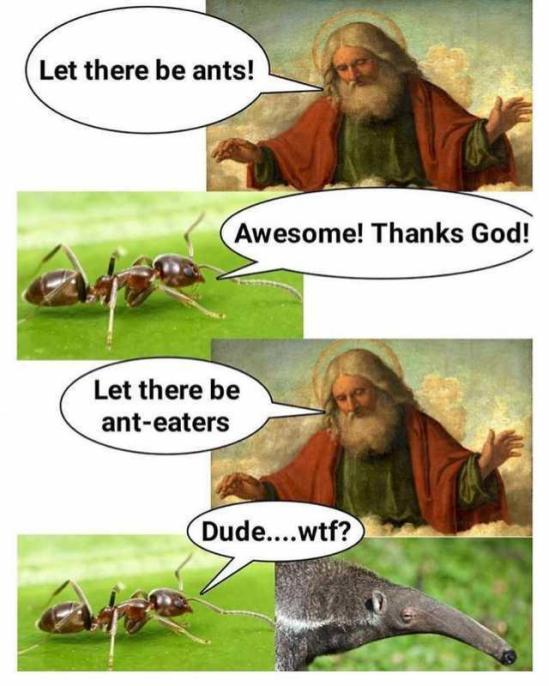
The Problem of Suffering
Stanley Rice says the following: “Many people thought of the natural world as God’s vast and orderly garden, full of life. Darwin showed the natural world to be violent and full of death.” Physicist Pascal Roux illustrates the great weight of theodicy, when he says that “[a]mong the questions which beset our age, that of evil in all its forms is perhaps the most painful and sometimes even the most obsessive.” To “interpret any facts which they find morally difficult as results of the fall” is an easy avenue for Christians to take (Christopher Southgate). This is an avenue that brings no solace when faced with the findings of science which prove that suffering, death, disease, and pain were present from the very beginning of life on earth. Southgate states that in light of theological anthropology and the problem of suffering, “Darwinism provides one of the most important rational elements informing a contemporary hermeneutic.”
In light of this, the following sections will explore the following: firstly, the “only way” argument, which states that this world is the only way which God could have made it; secondly, divine intervention; and thirdly, the suffering God, which has already been touched on in the previous section.
The Only Way
According to the view held by Pierre Teilhard de Chardin, evil is a secondary effect, a by-product of evolution. William Pollard and Christopher Southgate agree that the randomness and suffering in the natural world is unavoidable. Pollard states that “all must be allowed to result, whether by the wrong human choice or by truly random occurrence, because to allow any to be preventable by pre-determining human choice, would still be to gut the purpose of the Creation.” He goes on to mention a remark made by Rabbi Steinsaltz: “The Lord says, ‘Get me a thinking creature, I don’t care how.” As Southgate states: “I hold that the sort of universe we have, in which complexity emerges in a process governed by thermodynamic necessity and Darwinian natural selection, and therefore by death, pain, predation, and self-assertion, is the only sort of universe that could give rise to the range, beauty, complexity, and diversity of creatures the Earth has produced.” Natural selection would play the role of a natural mechanism to achieve this end. Natural selection is a costly mechanism. Arthur Peacocke asks whether there was not another way to reach the same ends and states that “there are inherent constraints on how even an omnipotent Creator could bring about the existence of a law-like creation that is to be a cosmos not a chaos, and thus an arena for the free action of self-conscious, reproducing complex entities and for the coming of the fecund variety of living organisms whose existence the Creator delights in.” The possibilities are not endless. There are physical constraints that cannot be passed over. Jack Mahoney explains that “God could do no other than accept the intrinsic characteristics of matter once he has decided to create it in the first place,” and quotes Gerard J. Hughes who has a similar view: “[I]n creating anything physical, as we understand that term, God inevitably creates limited, finite things which have the natures they do, rather than different things altogether. A world containing such limited things is a world in which not everything is still possible. To create is inevitably to decide. The laws of physics do not limit God’s power: they are simply a way of describing the limitations of the universe which God has chosen to create.” By creating, God chooses a certain set of constraints to be put into action.
It is not just recently that theologians have grappled with these kinds of questions. Thomas Aquinas wrestled with the same questions regarding suffering and came to a theodicy which speaks about the balance between good and harm: “Since God, then, provides universally for all being, it belongs to His providence to permit certain defects in particular effects, that the perfect good of the universe may not be hindered, for if all evil were prevented, much good would be absent from the universe.” In this view, the good outbalances the harms. This approach is called a good-harm analysis and may be formulated in three ways:
- Property-consequence: a consequence of the existence of good is that there is a possibility of it causing harms.
- Developmental: the good can only develop through a process that involves harm as either a possibility or necessity.
- Constitutive: the existence of a good is inherently and constitutively inseparable from the experience of harm.
With regard to harm caused by people, the property-consequence approach is used most often, whereas with evolutionary theodicies, the developmental approach is used most often. However, suffering is not just as a result of the natural processes, but also arises through human free will. Animals do not have the same capacities as humans do, and cannot exercise the same amount of free will. In spite of their more limited capacities, animals also experience suffering and pay for the cost of living. Conor Cunningham quotes biologist Ludwig von Bertalanffy, who states that: “Death was the consequence of the multicellular condition; pain the price of nervous integration; anxiety the price of consciousness.” In this way the whole of life has its part in the ubiquitous experience known as suffering. Southgate points to a concern raised by Wesley Wildman, which is that heaven would then be the best of all possible worlds, so why did God not create heaven and be done with it? The answer given by Southgate is that “though heaven can eternally preserve those selves, subsisting in suffering-free relationship, it could not give rise to them in the first place. Precisely this kind of universe is needed in order for life to evolve and become what it has become thus far.
Divine Intervention

Charles Darwin did not see the hand of God in designing creatures, and neither did he see it in events. His explanation of his stance, in a letter to his friend Asa Gray, states that:
One word more on ‘designed laws’ and ‘undesigned results.’ I see a bird which I want for food, take my gun and kill it, I do this designedly. An innocent and good man stands under a tree and is killed by a flash of lightning. Do you believe (and I really should like to hear) that God designedly killed this man? Many or most persons do believe this; I can’t and don’t. If you believe so, do you believe that when a swallow snaps up a gnat that God designed that that particular swallow should snap up that particular gnat at that particular instant? I believe that the man and the gnat are in the same predicament. If the death of neither man nor gnat are designed, I see no good reason to believe that their first birth or production should be necessarily designed.
With regard to the immense suffering and pain within the world, theologian and philosopher Austin Farrer poses the question: “Poor limping world, why does not your kind Creator pull the thorn out of your paw?” With regard to the role of chance in the mechanism of evolution, one might see God as:
the master of chance, intervening in a supernatural way, at times of his choosing, to restart, correct, reorientate creation and history when they parted company with his plans. This perspective is still compatible with the emergence of free beings at the heart of creation, but if we push it to extremes, we may end up with the image of a capricious God, and ultimately make creation unintelligible and all human action pointless (Plateaux & Godinot).
Seeing God as the Master of Chance becomes problematic in that it raises serious questions, e.g. why was one person struck by lightning, but another survived? It does make God seem capricious, like an unstable micro manager that might decide to flood a city for no apparent reason. If disasters are not seen as God’s work, the problem still remains as to why God didn’t prevent the disaster or somehow make sure all the people get out safely. Rudolph Brun states rather unambiguously that:
I cannot agree with any interventions of the Creator into the process of cosmogenesis, not for the origin of human beings, the emergence of life, or even during a few milliseconds at the beginning of the universe, because such supernatural interventions would jeopardize freedom. If God intervened in the creative process, God would also be responsible for not intervening – for accidents, catastrophes, indeed any conceivable evil. If there is manipulation by the Creator at any time during the process of cosmogenesis, then God is to blame for how creation has turned out.
Within theology, there are many different opinions about how God interacts with reality and has interacted in the process of evolution. There are those theologians, like Robert Russell and Nancey Murphy who maintain that God acts at the quantum level, using quantum indeterminacy to steer mutations in a specific direction. Arthur Peacocke sees the action of God as “whole-part constraint” where “the whole constrains the action of the part without violating any natural laws.” Terence L. Nichols proposes “contextual causality” in which that being influenced is the information content by the context of the part being influenced. For him, the ultimate context of the universe is God and the Spirit works by “catalyzing one form of development rather than another” instead of “specifying evolution in all the details”. Theoretical physicist and theologian John Polkinghorne made the following conclusion from the chaos theory: that the processes of the universe are open and thus God can work within them without violating natural laws. Aubrey Moore, Anglo-Catholic priest and one of the first Christian followers of Darwinism, makes the important observation that a theory of God’s occasional intervention implies God’s “ordinary absence.” If God intervenes only occasionally, what is God doing the rest of the time? Why are certain occasions seen as deserving intervention when others are not? Moore goes on to say that “[s]cience has pushed the deist’s God further and further away, and at the moment when it seemed as if he would be thrust out all together, Darwinism appeared, and, under the disguise of a foe, did the work of a friend. … Either God is everywhere present in nature, or he is nowhere.” The observation made by Christopher Southgate is significant here: “…this intervening God inserts modules of complexity into the natural order, but does not seem to intervene to mitigate suffering.” Why, if God can direct evolution, does He/She not direct it in such a way to eliminate the suffering and waste of so many organisms? Why allow something like the ebola virus to evolve? Wesley Wildman seeks to reconcile this apparent dichotomy by arguing that God is the ground of being and can be traced not only in the beauty, but also in the violence of the natural world. Wildman’s God is undeterminable and suffering in nature is “neither evil nor the byproduct of good. It is part of the wellspring of divine creativity in nature, flowing up and out of the abysmal divine depths like molten rock from the yawning mouth of a volcano.” Southgate rejects Wildman’s option on the ground that God is knowable in Jesus. Bram van de Beek agrees with Southgate when he says that the revelation of God through Jesus Christ is “central” and that all other revelations are orientated around this centre.
The issue of divine intervention comes back to that of the world as an other and God allowing it to be an other, as was touched upon in the section about panentheism. John Haught puts it simply: “genuine love risks allowing plenty of room for the spontaneity of the beloved.” A loved one who is coerced or forced to love is not a real partner in a relationship. If a man keeps his wife chained up in the house so she can’t leave, that isn’t love. She isn’t staying with him because she wants to, she’s staying with him because she has no choice. In the words of Jeffrey Korsmeyer: “God has all the power that a God could have who created a world with creatures who are really free.”
However, there is one event where God did intervene in the natural world, an event in which God stepped “down” into creation. Southgate speaks of the Incarnation as “the event by which God takes this presence and solidarity with creaturely existence to its utmost, and thus ‘takes responsibility’ for all the evil in creation – both the humanly wrought evil and the harms to all creatures.” According to Wolfhart Pannenberg, there is one event that proves that God truly is God and that is the Resurrection of Jesus Christ.
In the next installment we’ll look at The Suffering God.
Sources:
Brun R B. 2002. Cosmology, cosmic evolution, and sacramental reality: A Christian contribution. Zygon 37(1): 175-192.
Cunningham, C. 2010. Darwin’s pious idea: Why the ultra-Darwinists and creationists both get it wrong. Grand Rapids: William B Eerdmans.
Darwin, C. 1989. Autobiography in Darwin, F (ed.), The life and letters of Charles Darwin. Vol I. New York: D Appleton and Company. 25-86.
Durant, J (ed). 1985. Darwinism and divinity: Essays on evolution and religious belief. Oxford: Basil Blackwell.
Haught, J F. 2010. Making sense of evolution: Darwin, God, and the drama of life. Louisville: Westminster John Knox Press.
Mahoney, J. 2011. Christianity in evolution: An exploration. Washington: Georgetown University Press.
Montenat, C, Plateaux, L & Roux, P. (eds) 1985. How to read the world: Creation in evolution. London: SCM Press.
Nichols, T L. 2002. Evolution: Journey or random walk? Zygon 37(1): 193-210.
Peacocke, A. 1985. Biological evolution and Christian theology – Yesterday and today in Durant, J (ed). Darwinism and divinity: Essays on evolution and religious belief. Oxford: Basil Blackwell. 101-130
Peters, K E. 2007. Toward an evolutionary Christian theology. Zygon, 42(1): 49-63.
Plateaux, L. & Godinot M. 1985. The origin of life in Montenat, C, Plateaux, L & Roux, P. (eds) How to read the world: Creation in evolution. London: SCM Press. 19-36.
Rice, S A. 2007. Encyclopedia of evolution. New York: Facts on File.
Schaab, G L 2006. A procreative paradigm of the creative suffering of the Triune God: Implications of Arthur Peacocke’s evolutionary theology. Theological Studies 67: 542- 566.
Southgate, C. 2002. God and evolutionary evil: Theodicy in the light of Darwinism, Zygon 37(4): 01-824.
______2008. The groaning of creation: God, evolution, and the problem of evil. London: Westminster John Knox Press.
______2011. Re-reading Genesis, John, and Job: A Christian response to Darwinism, Zygon 46(2): 370-395.
Van de Beek, B. 2005. Toeval of schepping? Scheppingstheologie in de context van het modern denken. Kampen: Uitgeverij Kok.



